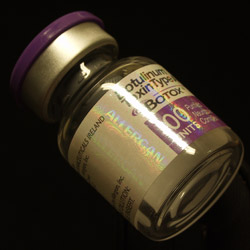• Botox: A neurotoxin drug that is by far the most common injectable, with more than three million procedures reported last year. Botox temporarily paralyzes muscles with a series of tiny shots, smoothing frown lines between the eyebrows and crow's feet around the eyes. It is the only neurotoxin approved for cosmetic use in the U.S. Lasts three to four months. Average physician fee: $363. From Allergan Inc., Irvine, Calif.
• Restylane: The second-most-common injectable, with about 700,000 procedures in the U.S. last year, Restylane is a filler that plumps up creases under the skin and is mostly used on the lower face. It is made from hyaluronic acid, a natural sugar that binds to water, creating temporary volume. Lasts six months or longer. Average price for all hyaluronic acids: $557. From
Medicis Pharmaceutical Corp. (A thicker version, Perlane, is awaiting FDA approval. Medicis is also developing other versions to complement its brand, including Lipp, Fine Lines and SubQ.)
• Juvéderm: A new hyaluronic acid in limited release that is going up against Restylane. Doctors like its ease of injection, but competition will focus on relative cost and duration. The cost to physicians is slightly more than Restylane, but retail pricing won't be clear until after Allergan officially launches Juvéderm in January. Allergan's older Hylaform and Captique products don't last as long as Juvéderm or Restylane.
• CosmoDerm: A collagen product that, unlike its 18-year-old predecessors, Zyderm and Zyplast, doesn't require an allergy skin test several weeks before treatment. Zyderm and Zyplast are harvested from cows, whereas CosmoDerm and its sister product CosmoPlast are made in a laboratory from human collagen, a natural component of the skin. CosmoPlast is used in deeper lines and furrows. Treatments are also popular in the lip border and fine lines above the mouth. Average fee for all collagen products: $390. Allergan.
• Radiesse: Made from tiny calcium particles that create a scaffold for the body's own collagen to grow. Approved for craniofacial surgery. In August, an FDA panel recommended approval for smile-line wrinkles, but the agency hasn't ruled yet. Some dermatologists who use it off-label for cosmetic applications caution that particles can migrate and cause nodules, especially in the lips. Some tests show it lasts perhaps a year or longer. Average fee: $914. From BioForm Medical Inc., San Mateo, Calif.
• Sculptra: A synthetic polymer that stimulates new collagen production. Approved in 2004 for treating facial fat loss in HIV patients, but used off-label by some cosmetic dermatologists. It is reported to last a year or more. There have been some reported incidences of delayed small bumps under the skin. Average physician fee: $876. From Dermik Laboratories, a unit of France's
Sanofi Aventis.
• ArteFill: A permanent implant approved last month for treating smile lines. Early versions of the product, sold in Europe and Canada, caused reactions called granulomas in some patients. Many doctors won't use it, but advocates say it's especially good for acne scars. Results are reported to be very dependent on the medical practitioner's technique. Price hasn't been announced. Artes Medical Inc., San Diego.
• Silicone: A permanent, liquid injectable that is making a comeback. Many doctors stopped using it a decade ago, especially after silicone breast implants were taken off the market. It remains controversial, but some dermatologists are using a purified product sold by
Alcon Inc. for eye surgery. Like ArteFill, it's an option for permanent filling of facial scars.
A collagen product developed by the Israeli company, Colbar LifeSciences, that was recently purchased by pharmaceutical titan
. Evolence is reported to be in late-stage human tests in the U.S. Dermatologists are buzzing about its potential to last a year or more and supplant other collagens on the market.
A hyaluronic acid filler, expected to last about six months, about the same duration as Restylane and Juvéderm.
Corp. launched Puragen in Europe last year. Puragen Plus includes an anesthetic, lidocaine, that the company says make the injections less painful than those of other fillers. Mentor hopes to launch in the U.S. late next year.
A biomaterial used in spine surgery that has been developed as a filler, expected to last about six months. Launched in the U.K. this summer. Entering U.S. human tests soon, possibly on the market in 2008. FzioMed Inc., San Luis Obispo, Calif.
A permanent filler made from a biomaterial used in contact lenses and other medical devices. Sold for cosmetic use throughout Europe. FDA human tests expected to begin in the U.S. soon. Contura International A/S, Denmark.
A Botox-like drug undergoing human tests in the U.S. Expected launch in 2008. Physicians hope it will break Botox's monopoly and bring down prices. Sold in Europe under the brand name Dysport. At the Palm Desert meeting, preliminary data were presented by a U.K. physician indicating it might not last as long as Botox. Medicis has U.S. rights.
Another potential Botox rival. Technology licensed by Mentor from the University of Wisconsin. A researcher there decades ago helped develop the purification process for botulinum toxin that later became Botox.
 JAMA has released an abstract showing that the doctor in Florida who injected himself and three others with botulism, may have used enough to kill himself 2857 times. They also state that "no cases of botulism with detectable serum toxin have previously been attributed to cosmetic or therapeutic botulinum toxin injections."
JAMA has released an abstract showing that the doctor in Florida who injected himself and three others with botulism, may have used enough to kill himself 2857 times. They also state that "no cases of botulism with detectable serum toxin have previously been attributed to cosmetic or therapeutic botulinum toxin injections."






